 |
| The Sleepwalker director/writer Mona Fastvold and co-writer/actor Brady Corbet: "Yes, juxtapositions are what we've been looking for." Photo: Anne-Katrin Titze |
Director/writer Mona Fastvold and co-writer/actor Brady Corbet of The Sleepwalker, starring Gitte Witt, Christopher Abbott, Stephanie Ellis and Corbet, connect Michael Haneke's Caché and Funny Games, in which Corbet starred with Naomi Watts, Tim Roth and Michael Pitt, to Ingmar Bergman's Hour Of The Wolf and Andrei Tarkovsky's Solaris. We discussed Borderline Films' productions of Sean Durkin's Martha Marcy May Marlene and Simon Killer by Antonio Campos and how it began for Corbet. Lars von Trier's love of Douglas Sirk and Melancholia led the discussion to the films of Claire Denis, Bruno Dumont, Jean-Pierre Dardenne and Luc Dardenne. Scarlett Johansson's performance in Jonathan Glazer's Under The Skin in contrast to an Aki Kaurismäki film conjures up choices for all filmmakers to consider.
With their beautiful baby girl in tow, Mona and Brady arrived on a chilly fall morning at IFC Films' Penn Plaza offices to talk about The Sleepwalker.
 |
| Stephanie Ellis as Christine and Gitte Witt as Kaia: "Well, it started with the two women first and then we sort of found their male counterparts." |
Sleepwalker is the story of two lost sisters. It is also the story of two couples and an inherited modern house in the woods that one of the couples is in the process of renovating. A fire, secrets from the past and in the present, a history of violence, and a need to bond, confess and adorn, are linking the four protagonists, like a weathercock. Mona Fastvold’s elegant juxtapositions of the ordinary and the outrageous hover like the mists over a forest pond. What secrets lie beneath, I tried to find out.
Anne-Katrin Titze: I'd like to start with the constellation of the four people in your film. Did you first have the idea of the constellation or did you have the individual characters first? It almost seems like a weather cock - north, south, east, west, especially in that beautiful dinner scene.
Mona Fastvold: Well, it started with the two women first and then we sort of found their male counterparts. We did want to create these archetypical characters and then play against it a little bit.
Brady Corbet: The whole movie flirts with the cliché in a very very intentional way. We never wanted it to just be a genre exercise but it's always an interesting point of access. It's a way to initially engage an audience with something that is so familiar to them. It's like [Brady switches to a dramatic whisper], the sister shows up in the middle of the night…
AKT: Were you thinking of any specific movies of that genre you are talking about?
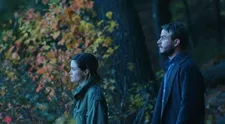 |
| Gitte Witt as Kaia Brady Corbet as Ira: "We always knew we were in a danger zone. If we make a misstep…" |
Brady: Well, those kinds of films I probably don't like very much, not necessarily. There are many films that have sort of subverted genre expectations like Hour Of The Wolf.
Mona: Or Caché.
Brady: Yeah, absolutely what Haneke did in Caché. Or even years ago when Tarkovsky made Solaris. There is a tradition of starting there and ending up somewhere else.
AKT: It's very interesting how you were dealing with the menace. Especially with your past roles, Brady, for example in Funny Games - which is very hard to get out of one's head seeing you. This is one of your great legacies, also a bit of the end of the world from Lars von Trier's Melancholia. These hang over your head when you arrive as Ira, the boyfriend in Sleepwalker. When you were writing the screenplay, how much did you take that into account?
Brady: Mona was a lot more cognizant of that than I was.
Mona: Oh, yeah. He is such a nice guy. I felt it was fine for people who knew Brady that they would automatically think - if this guy shows up, something terrible is going to happen. And the same with Chris [Abbott as Andrew]. Chris is such an incredibly charming and sweet guy and right away when you see him you just like him. To set up a red herring is really fun.
AKT: Facial hair for both of them?
Mona: I wanted to age them a little.
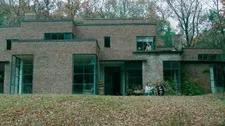 |
| The Sleepwalker family home: "I love beautiful architecture and I love all these details in creating this complete universe." |
Brady: Because both Chris and I are younger than the two young women in the film [Gitte Witt and Stephanie Ellis], by several years, actually.
AKT: I thought there might be more to it, something wolfish, maybe, because you pay so much attention to detail. Everything in the house seems carefully chosen.
Brady [to Mona]: Well, you're pretty fetishistic in general.
AKT: What do you mean by that?
Brady: Before Mona and I had a baby [who is in a deep sleep, taking in our conversation from the other side of the room], we were friends for a long time. Before we started working together, before we even met, I was working a lot with Borderline Films, the guys who made Martha Marcy May Marlene and Simon Killer in various capacities.
Mona had been making these very seductive, very very peculiar and exciting music videos that were like these really beautiful tone poems that have a lot in common with the movie. When she came to me - initially, she'd been working on the project with somebody else, and they had different ideas about the direction they had wanted to take the story.
Mona had grown up a sleepwalker. Sleepwalking is not really about anything. She didn't want to tell a story about sleepwalking but about the sense of dread she had when she 'slept-walked' as a child and a teenager. This foreboding sense that something intensely negative had occurred even though usually something quite banal had occurred. When you are dealing with metaphor or poetry of any sort, I like poetry that's quite straight forward, that's direct in a way. Usually, if you try to hide a metaphor it comes off even clumsier. For us the film's themes were always very very clear.
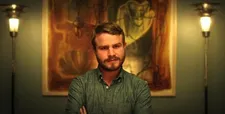 |
| Brady Corbet as Ira: "As a filmmaker or a painter, when you're dealing with esthetics, you're trying to give the audience something tangible that they can reach out and touch." |
Mona: And we wanted to address them. To say this is what we're talking about. This is what the film is about. Yes, all these things are metaphors, but they are apparent metaphors.
AKT: I like that approach. Often when you hide the symbolism, it comes back with a vengeance. The tone also has a hint of classic tales. There's a house in the woods, that doesn't have chicken feet, but could almost be a witch's house. There is fire, a possible first-born, although we don't even know if there is a baby. These are classic motives that work because the dialogue doesn't go in the same direction, babe, pal, hon, dude, brother, hey man! Is that a juxtaposition you were looking for?
Mona: Yes, juxtapositions are what we've been looking for. The dichotomy is really what we wanted to play with as much as possible. We wanted to have this very natural dialogue. We didn't want to improvise dialogue at all. We wanted it to be specific but quite naturalistic and at the same time you are in that slightly elevated universe.
Brady: We were constantly also talking about stylistically how you would move from something that's formally rigorous to something that was much looser, hand-held operating. That first sequence of them all in the kitchen.
AKT: The breakfast scene? I loved the detail about the pancakes. Pancakes with apple jam on the one hand is something very normal, and on the other hand, this is what the witch gives Hansel and Gretel in the fairytale to lure them in.
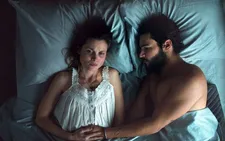 |
| Gitte Witt as Kaia and Christopher Abbott as Andrew: "Chris is such an incredibly charming and sweet guy…" |
Brady: Oh, my god, are you from her family?
AKT: We have the same coat! [When we met for our conversation, Mona and I both wore the same Isabel Marant tweed coat]
Mona: This is my audience!
Brady: That's very clear. I feel you're always reaching for the elemental. As a filmmaker or a painter, when you're dealing with esthetics, you're trying to give the audience something tangible that they can reach out and touch. Something that touches them. We always knew we were in a danger zone. If we make a misstep…
AKT: You end up in the coral snake pit…
Brady: Yeah, this can come off the wrong kind of melodrama. We love melodramas but we hate bad melodramas.
Mona: There was constant balancing. You have to balance the language with the esthetics. You have to balance the melodrama with having it play out in the wild, some dark and dramatic sequence with something that's quite silly.
AKT: I never was reminded of Douglas Sirk while watching your film, but it's a nice afterthought to put the two together.
Brady: Even if you're talking about filmmakers who are making notoriously bleak movies, like Lars von Trier. I mean, Lars, obviously fucking worships Douglas Sirk. They swoon in a way. Movies have gone in a peculiar direction. About 30 years ago, or 25 years ago, due to the work of great filmmakers like Claire Denis and the Dardenne brothers or Bruno Dumont, there was sort of this feeling like, oh, people need to… Modern cinema is an anti-cinema. It's a cinema with no score, it's stark with a lot of tracking shots.
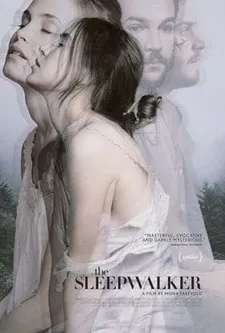 |
| The Sleepwalker poster |
Mona: Tracking the back of their heads.
Brady: Shielding their expressions. It was a movement. It's gotten to the point that if you see a lot of contemporary movies, you see a lot of people doing this and they're not doing it very well. It feels kind of redundant and tired. We want movies to be really exciting again. Maintain the modern advances - you can be more restrained, audiences are more patient, they are clever because they receive information a different way because they know so much about the process of making movies. Audiences are aware of things like exposition. Audiences 50 years ago weren't talking about things like that. I think that DVDs, Behind the Scenes, all that stuff, commentary, all this context reshaped the way people watch movies.
Mona: Which is so exciting because then you can make a contract with the audience and then brake it and try and trick them. Because they know so much.
AKT: About the bleakness, you made the decision that you weren't going there.
Mona: That's not my world. My universe is lush and seductive and kind of shocking and rotten.
AKT: The location is a beautiful house.
Mona: I love beautiful architecture and I love all these details in creating this complete universe.
AKT: The costumes are a great part of that too, as Kaia collects vintage clothes. You brought up Michael Haneke earlier and I was so glad you didn't include any animals in your movie. Only cats seem to be safe in his films. I spoke with Yves Montmayeur about this. He made the documentary Michael H. Profession: Director. It's so clear, any animal you see in a Haneke film is going to die. Also With Lars von Trier you worry.
Brady: Yeah with Lars animals aren't safe.
AKT: You can almost go by filmmaker. With Aki Kaurismäki, you can be certain that nothing will happen to the animal.
Brady: Right. I think our favorite scene from a movie this year is the scene in Under The Skin where the dog goes running out into the water and the family there, they have a baby and they stupidly run after it. And there's that weird moment in the film about how from an alien perspective it's so strange to be more connected to your dog than your child.
Mona: And you think she is going to save him and she just whacks his head. It's so animalistic.
Brady: She kills the father.
AKT: And leaves the baby on the beach. She's an alien [Jonathan Glazer on Under The Skin].
Brady: Because she doesn't know what to do with the baby. It's an amazing sequence. We'll be hurting animals in a theater sometime in the future.
AKT: No. I would like you to be among the ones where one can feel safe.
In part 2, working with Bertrand Bonello, on Mia Hansen-Løve's Eden and with Olivier Assayas, the banality of evil and the evil of banality, an upcoming project with Bérénice Bejo, Tim Roth, Stacy Martin and Robert Pattinson - everyone from John Fowles to Jean-Paul Sartre and Volker Schlöndorff's Young Törless.
The Sleepwalker opened in New York on November 21.





















